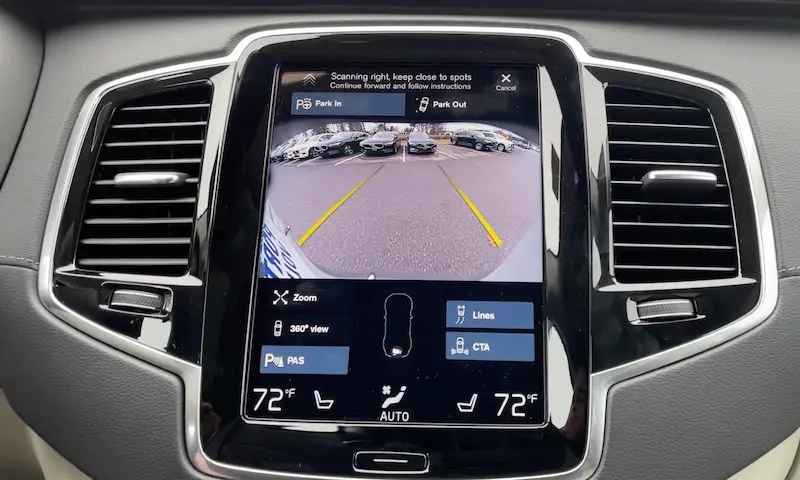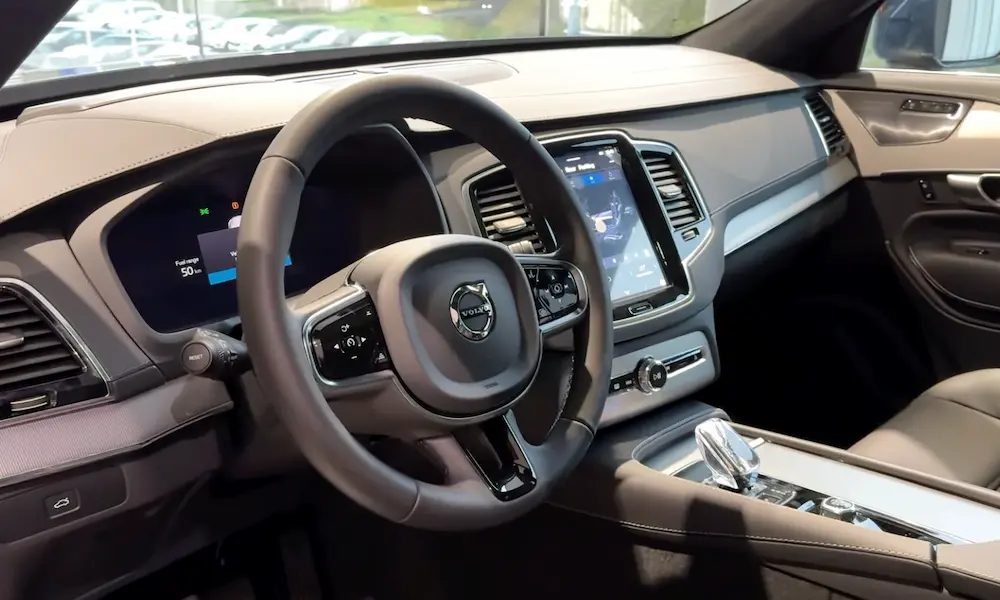Is your Volvo flashing that annoying “DSTC Service Required” message? You’re not alone if you’re wondering what’s happening with your car’s stability system. This warning means your Volvo’s safety net has a problem that needs attention, but don’t worry—we’ll walk through everything you need to know to get your vehicle back to full protection.
What is DSTC and Why Should You Care?
DSTC (Dynamic Stability and Traction Control) is Volvo’s guardian angel for your driving safety. It’s not just a fancy feature—it could save your life.
This system continuously monitors your car’s movement using several sensors. It compares what you’re trying to do (through your steering and braking) with what your car is actually doing. When there’s a mismatch—like when you’re sliding on ice—DSTC steps in to help.
When working properly, your DSTC:
- Prevents wheel spin during acceleration
- Stabilizes your car during emergency maneuvers
- Helps maintain control on slippery roads
- Reduces the risk of skidding or rollover
A normal DSTC indicator briefly lights up during startup for a self-check, then turns off. If it flashes while driving, that means it’s actively working to keep you stable.
What “DSTC Service Required” Actually Means
When you see “DSTC Service Required” on your dashboard, it’s telling you something specific: your stability system has detected a fault and has disabled itself.
This doesn’t mean your car is unsafe to drive, but it does mean:
- Your stability control is currently not working
- You won’t have electronic intervention during skids
- You’ll need to drive more cautiously, especially in bad weather
- The underlying issue needs diagnosis and repair
Think of it like driving without your safety net—the car will still drive, but you’ve lost a significant safety feature that modern Volvos are known for.
The Most Common Causes Behind the Warning
After analyzing hundreds of Volvo DSTC issues, certain patterns emerge. Here are the most likely culprits behind your warning light:
1. Yaw Rate Sensor Issues
The yaw rate sensor is often the primary troublemaker. Located under the passenger seat, this sensor measures your car’s rotation around its vertical axis—essentially how much your car is spinning.
This sensor frequently fails due to:
- Water damage (especially after heavy rain)
- Connector corrosion
- Internal electronic failure
In a detailed video analysis, Volvo specialists show that a faulty yaw sensor typically triggers only the DSTC light without activating other warning systems.
2. Wheel Speed Sensor Problems
Each wheel has a speed sensor that tells your car’s computer how fast that wheel is turning. When one sensor reports different speeds than the others, your DSTC assumes something’s wrong.
Common wheel sensor issues include:
- Physical damage to the sensor
- Broken wires in the harness
- Dirty sensor face or tone ring
- Excessive rust on the tone ring behind the wheel
Wheel speed sensor failures often trigger both ABS and DSTC warnings simultaneously.
3. Steering Angle Sensor Failure
Your Volvo needs to know exactly where your steering wheel is positioned. The steering angle sensor provides this crucial information.
When it fails, your car can’t determine if you’re turning intentionally or sliding unintentionally. This directly affects the DSTC system’s ability to function properly.
4. Electrical Connection Problems
Sometimes there’s nothing wrong with the sensors themselves—just the connections between them and the computer. Corroded or loose connections cause intermittent problems that are frustrating to diagnose.
Many drivers report their DSTC warning appearing and disappearing randomly, especially after driving through puddles or during rainy weather. This unpredictable behavior often points to connection issues rather than complete sensor failure.
5. Damaged Tone Rings
Inside your wheel assembly, a toothed metal ring (tone ring) spins past the wheel speed sensor. If this ring becomes damaged or excessively rusted, it can send erratic signals.
Tone rings can be damaged by:
- Impact with curbs or potholes
- Excessive corrosion in winter regions
- Previous improper repairs
- Manufacturing defects
Many Volvo forums report that damaged tone rings create random DSTC faults that are difficult to trace.
How to Diagnose the Problem Yourself
Before spending big money at the dealer, try these diagnostic steps:
Step 1: Proper Code Scanning
Generic OBD-II scanners often can’t access Volvo’s DSTC system properly. You’ll need either:
- A Volvo-specific scanner (like VIDA)
- A high-end scanner with Volvo capabilities
- A visit to a shop with proper diagnostics
The right scanner will tell you exactly which component is reporting a fault, saving you from guessing or replacing parts unnecessarily.
Step 2: Try a Hard Reset
Sometimes electronics just need a reset. Here’s how:
- Park your car safely
- Turn off the ignition completely
- Wait at least 10 minutes (this allows capacitors to fully discharge)
- Restart the car and drive for about 5 miles
This simple step can sometimes resolve temporary glitches, especially if connections have just dried out after exposure to moisture.
Step 3: Inspect the Yaw Rate Sensor
Since the yaw rate sensor is the most common culprit, it deserves special attention:
- Locate the sensor under the passenger seat (you may need to remove trim panels)
- Check for visible water damage or corrosion
- Disconnect and reconnect the sensor to ensure good contact
- Clean connections with electronic contact cleaner
- Apply dielectric grease to protect connections
This relatively simple check can save you hundreds of dollars if connection issues are causing your problem.
Step 4: Examine Wheel Speed Sensors
For a thorough check:
- Jack up your car safely (one wheel at a time is fine)
- Remove the wheel for better access
- Locate the wheel speed sensor (usually mounted to the wheel hub)
- Check for physical damage, dirt, or debris
- Inspect the wiring for breaks or chafing
- Look at the tone ring for damage or excessive rust
- Clean the sensor face with a soft brush
As demonstrated in this detailed guide, wheel speed sensors can often be cleaned rather than replaced.
Professional Repair Options and Costs
If your DIY efforts don’t resolve the issue, you’ll need professional help. Here’s what to expect:
Yaw Rate Sensor Replacement
This is often the ultimate solution for persistent DSTC warnings:
- Part cost: $400-$800 (OEM sensor)
- Labor: $150-$300
- Programming: $100-$200 (required with new sensor)
- Total: $650-$1,300
The high cost is because the sensor requires programming with Volvo’s proprietary VIDA system after installation.
Wheel Speed Sensor Replacement
If you’ve confirmed a specific wheel sensor is faulty:
- Part cost: $50-$150 per sensor
- Labor: $50-$150 per sensor
- Coding: Usually not required
- Total: $100-$300 per wheel
This is a much more affordable fix, especially if you can replace the sensor yourself. Aftermarket sensors are available for many Volvo models and can save you significant money.
Steering Angle Sensor Repair
This typically requires steering column work:
- Part cost: $200-$500
- Labor: $200-$400 (due to steering column disassembly)
- Calibration: Often required, $100-$200
- Total: $500-$1,100
This repair is more involved because of the sensor’s location and safety implications.
Connection Repair
If corroded connections are your issue:
- Parts: $20-$50 (connectors and terminals)
- Labor: $100-$300 (depending on location difficulty)
- Total: $120-$350
Many shops can clean and repair corroded connections for much less than replacing entire sensors, which is why proper diagnosis is crucial.
Preventative Measures to Avoid Future Problems
Once you’ve fixed your DSTC system, take these steps to prevent recurrence:
Protect Against Moisture
Water is the enemy of electronic systems:
- Apply dielectric grease to all sensor connections
- Ensure body drain holes are clear
- Address any water leaks promptly
- Consider adding silicone sealant around sensitive connections
Regular Inspection
Make these checks part of your maintenance routine:
- Visually inspect wheel speed sensors when rotating tires
- Check for loose connections after driving through deep water
- Pay attention to early warning signs (intermittent DSTC light)
- Keep wheel wells clean in winter to prevent salt corrosion
Software Updates
Volvo occasionally releases software updates that can improve DSTC reliability:
- Ask about available updates during regular service
- Some updates specifically address known sensor sensitivity issues
- Modern Volvos may receive over-the-air updates
Driving Safely Without DSTC
If you need to drive while your DSTC is disabled:
- Reduce speed in adverse conditions
- Allow extra stopping distance
- Be especially cautious on curves in wet or icy conditions
- Avoid sudden steering movements
- Remember that your ABS system may still be functional
According to safety reports, driving without stability control increases accident risk by 30-40% in adverse conditions.
Understanding the Modern Volvo Safety System Integration
Your DSTC system doesn’t work in isolation—it’s part of Volvo’s integrated safety architecture:
| System | Relationship to DSTC | Shared Components |
|---|---|---|
| ABS | Direct integration | Wheel speed sensors, hydraulic control unit |
| Traction Control | Subset of DSTC | Uses same sensors and control unit |
| Electronic Brake Distribution | Works alongside DSTC | Shares hydraulic controller |
| Collision Avoidance | Uses DSTC for intervention | Shares steering and brake controllers |
This integration is why proper diagnosis is so important—what appears as a DSTC issue could impact multiple safety systems. Reddit discussions show how fixing one component often resolves multiple warnings.
Real-World Experiences from Volvo Owners
Volvo community forums reveal useful patterns:
- Many owners report the warning appearing first after heavy rain
- The issue frequently occurs on vehicles 6-10 years old
- Some experience the warning only in cold weather
- DIY fixes work in about 40% of cases
- Yaw sensor replacement reliably solves the problem when connections aren’t the issue
As one owner noted: “After replacing the yaw sensor, not only did my DSTC warning disappear, but my car actually handles winter conditions noticeably better.”
The Bottom Line on DSTC Service Required
The “DSTC Service Required” warning is your Volvo telling you an important safety system needs attention. While the car remains drivable, you’re missing a valuable safety feature until the issue is resolved.
Start with proper diagnosis before replacing expensive components. In many cases, connection issues or simple sensor cleaning can resolve the problem without breaking the bank.
Remember that while driving without DSTC is possible, it significantly reduces your vehicle’s ability to help you recover from skids and slides—exactly when you need help most.









